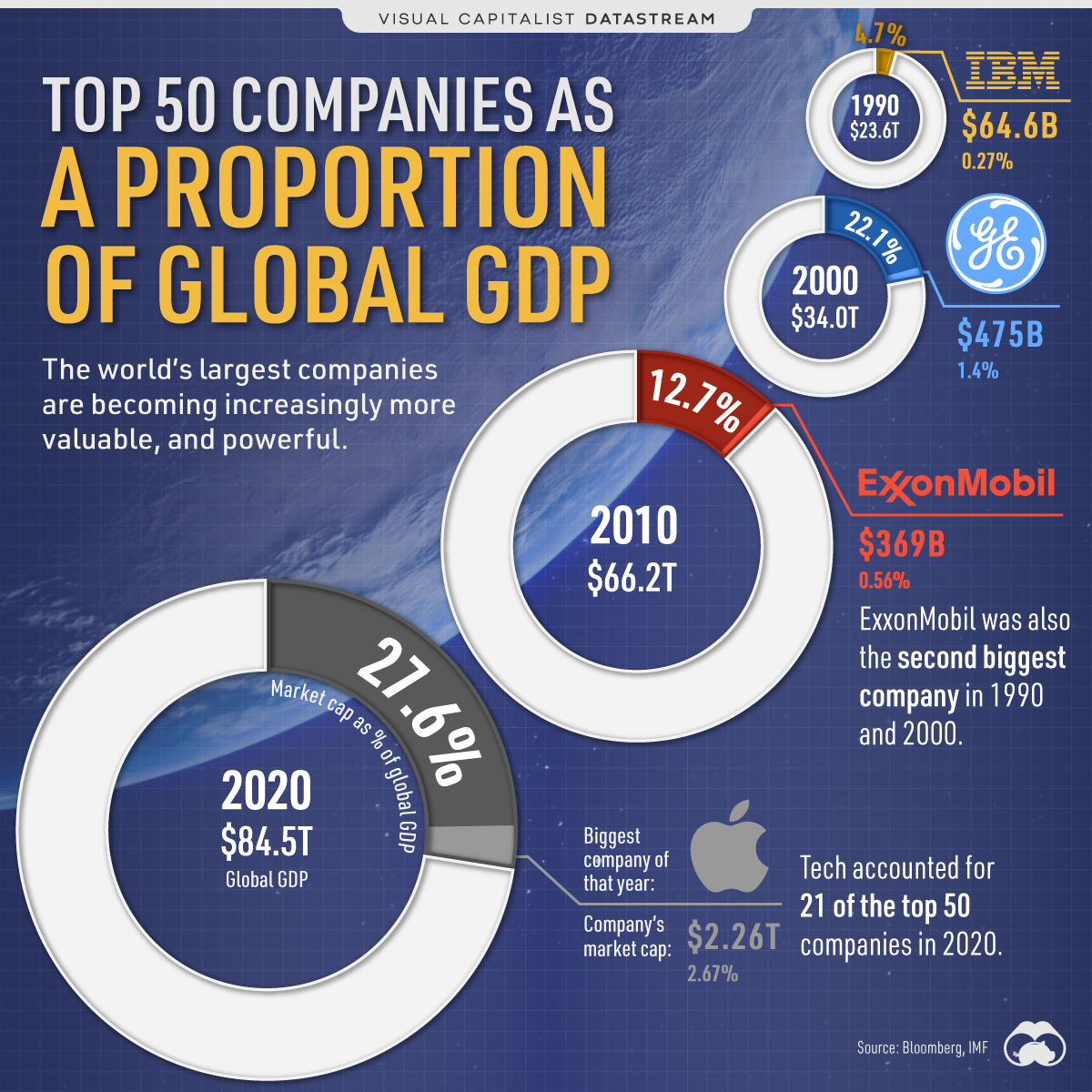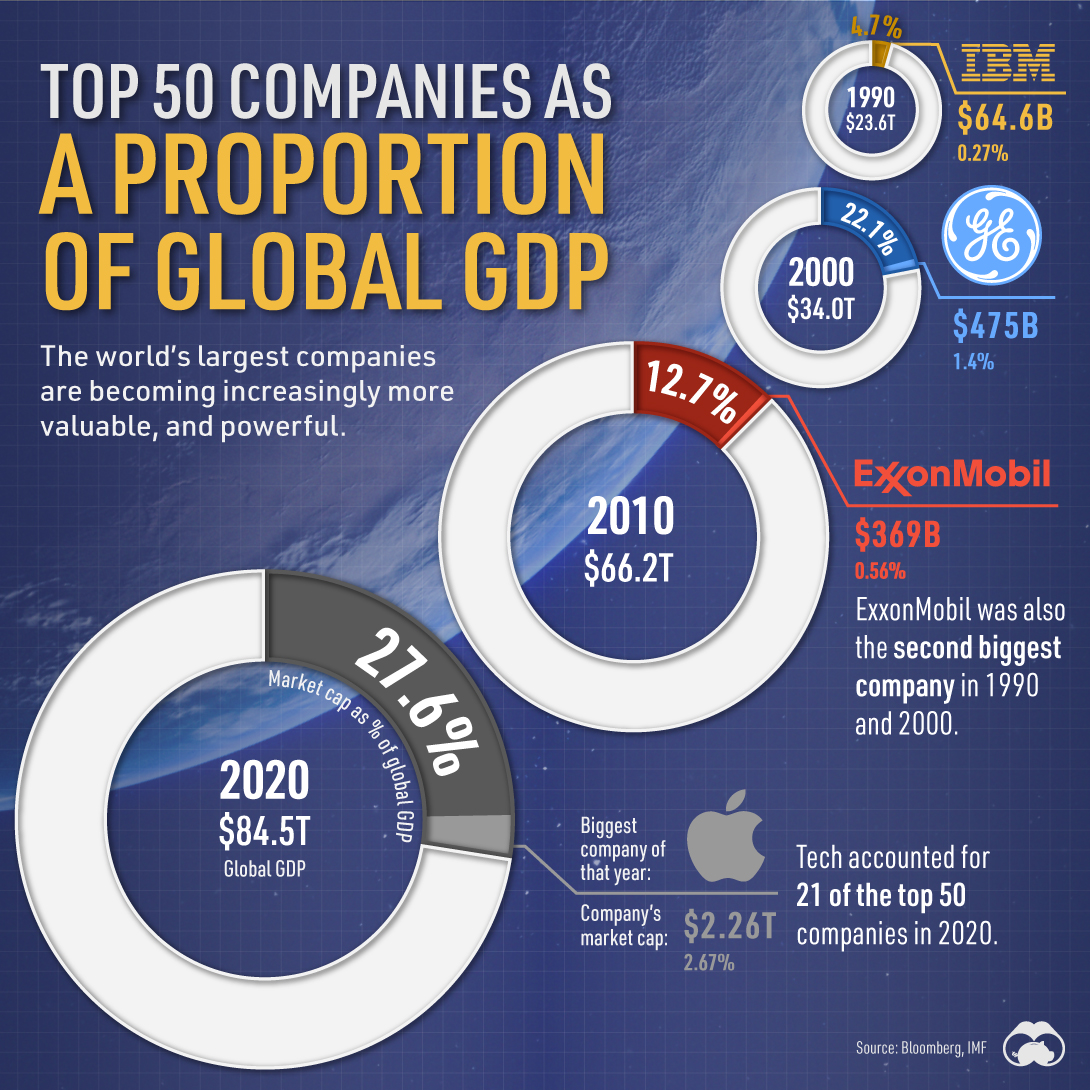Datastream
Top 50 Companies Proportion of World GDP

The Briefing
- The combined market cap of the world’s top 50 companies was proportional to 27.6% of global GDP in 2020, up from just 4.7% of global GDP in 1990
- Tech’s role continues to grow, now accounting for 21 of the top 50 companies
Top 50 Companies Proportion of World GDP
The world’s top 50 companies have become increasingly more valuable, and more powerful, over time.
As global GDP has grown over the last four decades, from $23.6 trillion in 1990 to $84.5 trillion in 2020, the proportional share of the world’s top companies by market capitalization has grown over five-fold.
| Year | Global GDP | Top 50 Companies Market Cap as a % of GDP |
|---|---|---|
| 1990 | $23.6T | 4.7% |
| 2000 | $34.0T | 22.1% |
| 2010 | $66.2T | 12.7% |
| 2020 | $84.5T | 27.6% |
Though the world’s top 50 companies change year-to-year, there’s also a lot of overlap.
Which Companies Dominated Each Decade?
2020’s largest company by market cap, Apple at $2.26 trillion, was the third largest company in 2010. Likewise, 2010’s largest company was Exxon Mobil, which was the second largest company in both 1990 and 2000 (but has since fallen off).
The top 50 companies in the world also highlight the increasing role of tech in the modern market. 1990’s largest company IBM was just one of three tech companies that made the ranking that year. Even in 2000, when the world’s largest company was GE, tech companies like Cisco and Microsoft only made up three of the top 10 companies by market cap.
Fast forward to 2020, and tech accounted for 42% of the top 50 companies in the world. It also plays a more prominent role on the high end of the spectrum, as six of 2020’s seven largest companies were tech-based, with only oil giant Saudi Aramco the odd one out.
Though digitization is a primary driver of current economic growth, will these trends remain steady in 10 or more years from now? Or will companies from other booming industries such as green energy take over the leaderboard?
>>Like this? You might find this article interesting, 23 Years of Shifting Tech Market Caps
Datastream
Can You Calculate Your Daily Carbon Footprint?
Discover how the average person’s carbon footprint impacts the environment and learn how carbon credits can offset your carbon footprint.

The Briefing
- A person’s carbon footprint is substantial, with activities such as food consumption creating as much as 4,500 g of CO₂ emissions daily.
- By purchasing carbon credits from Carbon Streaming Corporation, you can offset your own emissions and fund positive climate action.
Your Everyday Carbon Footprint
While many large businesses and countries have committed to net-zero goals, it is essential to acknowledge that your everyday activities also contribute to global emissions.
In this graphic, sponsored by Carbon Streaming Corporation, we will explore how the choices we make and the products we use have a profound impact on our carbon footprint.
Carbon Emissions by Activity
Here are some of the daily activities and products of the average person and their carbon footprint, according to Clever Carbon.
| Household Activities & Products | CO2 Emissions (g) |
|---|---|
| 💡 Standard Light Bulb (100 watts, four hours) | 172 g |
| 📱 Mobile Phone Use (195 minutes per day)* | 189 g |
| 👕 Washing Machine (0.63 kWh) | 275 g |
| 🔥 Electric Oven (1.56 kWh) | 675 g |
| ♨️ Tumble Dryer (2.5 kWh) | 1,000 g |
| 🧻 Toilet Roll (2 ply) | 1,300 g |
| 🚿 Hot Shower (10 mins) | 2,000 g |
| 🚙 Daily Commute (one hour, by car) | 3,360 g |
| 🍽️ Average Daily Food Consumption (three meals of 600 calories) | 4,500 g |
| *Phone use based on yearly use of 69kg per the source, Reboxed | |
Your choice of transportation plays a crucial role in determining your carbon footprint. For instance, a 15 km daily commute to work on public transport generates an average of 1,464 g of CO₂ emissions. Compared to 3,360 g—twice the volume for a journey the same length by car.
By opting for more sustainable modes of transport, such as cycling, walking, or public transportation, you can significantly reduce your carbon footprint.
Addressing Your Carbon Footprint
One way to compensate for your emissions is by purchasing high-quality carbon credits.
Carbon credits are used to help fund projects that avoid, reduce or remove CO₂ emissions. This includes nature-based solutions such as reforestation and improved forest management, or technology-based solutions such as the production of biochar and carbon capture and storage (CCS).
While carbon credits offer a potential solution for individuals to help reduce global emissions, public awareness remains a significant challenge. A BCG-Patch survey revealed that only 34% of U.S. consumers are familiar with carbon credits, and only 3% have purchased them in the past.
About Carbon Streaming
By financing the creation or expansion of carbon projects, Carbon Streaming Corporation secures the rights to future carbon credits generated by these sustainable projects. You can then purchase these carbon credits to help fund climate solutions around the world and compensate for your own emissions.
Ready to get involved?
>> Learn more about purchasing carbon credits at Carbon Streaming
-

 Energy1 week ago
Energy1 week agoThe World’s Biggest Nuclear Energy Producers
-

 Money2 weeks ago
Money2 weeks agoWhich States Have the Highest Minimum Wage in America?
-

 Technology2 weeks ago
Technology2 weeks agoRanked: Semiconductor Companies by Industry Revenue Share
-

 Markets2 weeks ago
Markets2 weeks agoRanked: The World’s Top Flight Routes, by Revenue
-

 Countries2 weeks ago
Countries2 weeks agoPopulation Projections: The World’s 6 Largest Countries in 2075
-

 Markets2 weeks ago
Markets2 weeks agoThe Top 10 States by Real GDP Growth in 2023
-

 Demographics2 weeks ago
Demographics2 weeks agoThe Smallest Gender Wage Gaps in OECD Countries
-

 United States2 weeks ago
United States2 weeks agoWhere U.S. Inflation Hit the Hardest in March 2024















